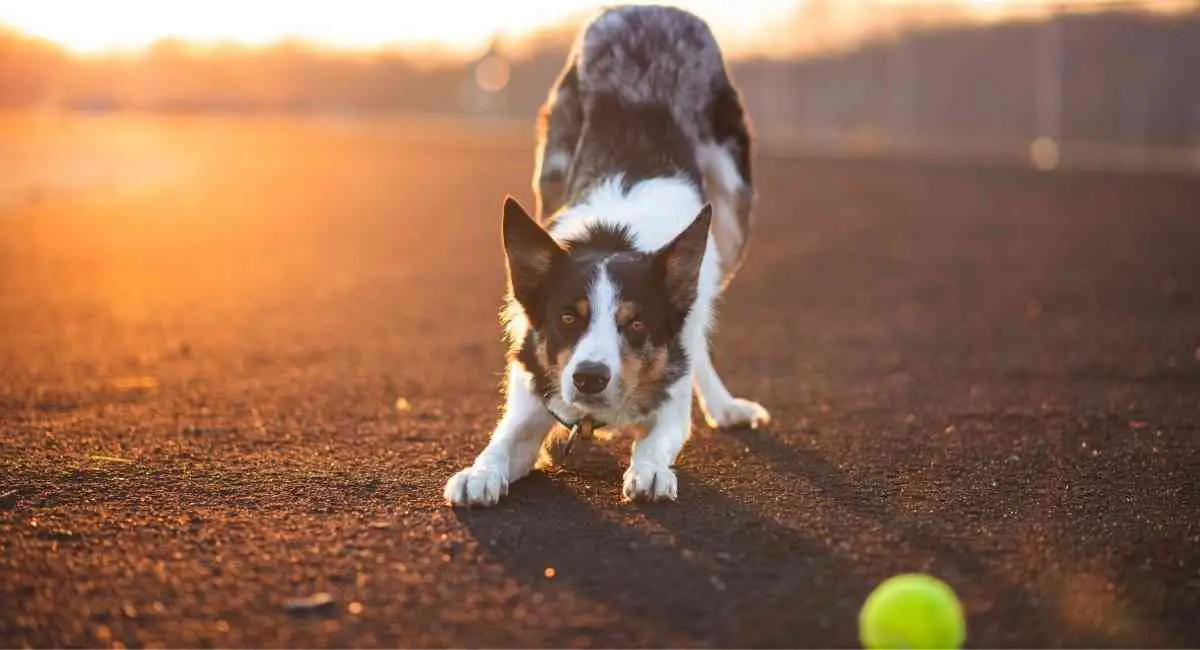Dogs communicate in a lot of ways and believe it or not, barking is actually the second most effective method. According to TUFTS University, the first way for them to communicate is body language and one of the most common ways of expression is a dog greeting stretch.
Seeing your dog excitedly waiting for you to come home may just be the best part about being a dog owner. Sometimes, you’ll notice them doing a little stretch too and you might ask yourself is it time to exercise? Did they just wake up? Or worse, are they in pain?
As a dog owner, it is important to know all the ways a dog may communicate to you so their feelings are correctly realized and taken care of. So, let’s dive in to understand what a greeting stretch is and more!

What is a Dog’s Greeting Stretch and What Does it Mean?
The greeting stretch, in short, is just a simple hello to you and it is usually denoted by a lowered front and a raised behind. It can vary from dog to dog and take many forms such as:
- A lean-forward position with the rear legs stretched out
- Elbows off the ground, a lowered front and a raised behind
- Elbows on the ground, lean-forward position and the rear legs stretched out
- Front legs stretched out followed by a rear leg stretch
How can you tell it is a greeting stretch and not something more concerning? Well, the dog will usually have its nose oriented up towards its owner, eyes soft and squinting as if they just woke up and a docile, friendly attitude to welcome you home.
Dogs usually only greet people they like and feel comfortable with. So, the posture will definitely be unrestrained, respectful, and inviting.
The front legs will be braced, the tail will be up, the ears will be raised but unlike the prey posture, the dog will be relaxed and ready to play. This is why the greeting stretch is also sometimes known as an ‘I love you’ stretch.
Most dog owners confuse the ‘hello’ stretch and think their dog is warming up for a healthy run around the park or that they are shaking off their sleep.
Knowing what your dog is trying to tell you can make them feel heard, respected, and ultimately improve the bond you have with them for life.
Are There Different Types of Dog Stretches?
Yes! Since a dog’s most common way of communication is using their body, there are a number of stretches you’ll find a dog doing and each of them may mean something different. Here are a few you might want to know:
Play Stretch
If you find your dog wagging their tail vigorously, seeming happy and softly panting, it is an indication that they are ready to go fetch.
Splooting
Mostly seen in long-legged breeds like labradors, splooting is when a dog has his rear legs stretched out flat, their belly resting and head lowered. It is mostly for comfort and to cool down in the summers.
Scratch Stretch
Dogs love a good belly rub and it gets their legs to kick and twitch as if they are ‘tickled’. However, it is an involuntary response and most dogs extend their legs as a defence mechanism. That isn’t to say they aren’t comfortable so if you find your dog on his back, give their tummy a little rub.
Embarrassed Stretch
Dogs tend to show many, if not all, emotions through their body language and if they are embarrassed, you will find them with their tails between their legs, limp, and in a cowering posture as well as their body tucked into themselves as if they are ‘hiding’.
Sore Muscle Stretch
Most dogs raise their behind and extend their front legs before running off or walking with their owner. It helps them warm up and get blood flowing, especially when it has been some time since they exercised. This is most common in active breeds like huskies.

Can a Dog’s Stretching Be a Cause for Concern?
Not necessarily. Dogs primarily stretch to relay their feelings, thoughts, and needs to their owner. However, where health is concerned, even their stretches count. If you find your dog excessively stretching it may be due to the following reasons:
Abdominal Pain
Dogs with pain or pressure in the abdominal area will most likely stretch in a ‘bowing’ position, i.e. their chest and front legs will lean towards the floor and their behind will be raised. If their stomach seems larger than normal or vomiting persists for more than 30 hours, it is time to call the vet.
Mating Ritual
Most dogs in heat will stretch excessively, especially if there is a sexual partner around. Unless they are neutered, stretching in breeding dogs is quite common and isn’t very concerning. They will mostly be found doing a ‘downward dog stretch’ to feel comfortable.
Separation Anxiety
Some dog breeds like vizslas, chihuahuas, and pugs are born ‘needy’ or with an obsessive tendency to attach to their owner and they are most commonly regarded as ‘clingy dog breeds’.
They are most prone to separation anxiety and may be seen stretching abnormally when they are anxious or left alone. With adequate attention, most will remain calm and steady.
Final Thoughts
Dogs are faithful, protective and promote a healthy lifestyle but they have needs, too. To understand them, we must learn the art of their nonverbal communication.
Do proper research on the dog breed coming home, learn tips and tricks to handle them, and train them to their best potential.
So, now that you know what a dog greeting stretch is, how many other stretches there are, and when they can become an issue, you should now be suited to take care of your dog in a better and improved manner.
